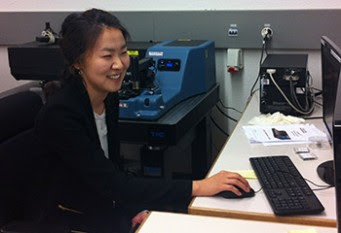Home > Press > EPFL Scientists use nanoscale IR spectroscopy to demonstrate α to β secondary structure transition associated with amyloid formation
 |
| The Anasys nanoIR system installed in the lab of Prof. Kulik from Prof. Dietlerís group at EPFL. |
Abstract:
Anasys Instruments reports on EPFL's latest research on lysozyme droplets and α-synuclein macromolecular aggregates illustrating application of the nanoscale AFM-IR technique to demonstrate α to β secondary structure transition associated with amyloid formation.
EPFL Scientists use nanoscale IR spectroscopy to demonstrate α to β secondary structure transition associated with amyloid formation
Santa Barbara, CA | Posted on June 10th, 2014Proteins aggregating into amyloid structures are involved in important neurodegenerative disorders such as Alzheimer's and Parkinson's disease. During aggregation, initially monomeric proteins undergo internal structural rearrangement forming amyloid fibrils with a universal cross β -sheet quaternary structure. . During fibrillation, several coexisting amyloidogenic species are formed and the study of these species would allow improved understanding of the pathways of amyloid formation.
Conventional FTIR spectroscopy is a key method for studying the structural conversion during amyloid formation but it is only able to give average spectra of a heterogeneous solution due to its poor spatial resolution. Sub-micron chemical characterization, enabled by the AFM-IR technique, of amyloidogenic structures such as oligomers and fibrils is central to understanding how proteins misfold and aggregate. The researchers clearly resolved the shift in the amide I band which identifies an α to β secondary structure transition associated with amyloid formation and were able to spatially map the transition. This work was published in the journal Lab on a Chip [1].
The analytical system used for this research is the nanoIR product manufactured by Anasys Instruments. Andrzej Kulik, the main researcher behind this effort at EPFL, has described AFM-IR as "one of the most important breakthroughs in the AFM technique since it adds chemical composition information to nanoscale morphology. Its ease of use will ensure its wide adoption given the crucial importance of nanoscale chemical composition in most research applications."
####
About Anasys Instruments
Anasys Instruments designs breakthrough, award-winning products that provide nanoscale probe based analytical techniques while providing high quality AFM imaging. We pioneered nanoscale IR spectroscopy, nanoscale thermal analysis and wideband nanoscale dynamic mechanical spectroscopy.
For more information, please click here
Contacts:
Anasys contact:
Roshan Shetty
Anasys Instruments Corporation
121 Gray Avenue, Suite 100
Santa Barbara
CA 93101 USA
Tel: +1 (805) 730-3310
www.anasysinstruments.com
Media contact:
Jezz Leckenby
Talking Science Limited
39 de Bohun Court
Saffron Walden
Essex CB10 2BA, UK
Tel +44 (0) 1799 521881
Mob +44 (0) 7843 012997
www.talking-science.com
Copyright © Anasys Instruments
If you have a comment, please Contact us.Issuers of news releases, not 7th Wave, Inc. or Nanotechnology Now, are solely responsible for the accuracy of the content.
| Related Links |
| Related News Press |
News and information
![]() Simulating magnetization in a Heisenberg quantum spin chain April 5th, 2024
Simulating magnetization in a Heisenberg quantum spin chain April 5th, 2024
![]() NRL charters Navyís quantum inertial navigation path to reduce drift April 5th, 2024
NRL charters Navyís quantum inertial navigation path to reduce drift April 5th, 2024
![]() Discovery points path to flash-like memory for storing qubits: Rice find could hasten development of nonvolatile quantum memory April 5th, 2024
Discovery points path to flash-like memory for storing qubits: Rice find could hasten development of nonvolatile quantum memory April 5th, 2024
Lab-on-a-chip
![]() Micro-scale opto-thermo-mechanical actuation in the dry adhesive regime Peer-Reviewed Publication September 24th, 2021
Micro-scale opto-thermo-mechanical actuation in the dry adhesive regime Peer-Reviewed Publication September 24th, 2021
![]() Silicon-graphene hybrid plasmonic waveguide photodetectors beyond 1.55 μm March 13th, 2020
Silicon-graphene hybrid plasmonic waveguide photodetectors beyond 1.55 μm March 13th, 2020
Discoveries
![]() Chemical reactions can scramble quantum information as well as black holes April 5th, 2024
Chemical reactions can scramble quantum information as well as black holes April 5th, 2024
![]() New micromaterial releases nanoparticles that selectively destroy cancer cells April 5th, 2024
New micromaterial releases nanoparticles that selectively destroy cancer cells April 5th, 2024
![]() Utilizing palladium for addressing contact issues of buried oxide thin film transistors April 5th, 2024
Utilizing palladium for addressing contact issues of buried oxide thin film transistors April 5th, 2024
Announcements
![]() NRL charters Navyís quantum inertial navigation path to reduce drift April 5th, 2024
NRL charters Navyís quantum inertial navigation path to reduce drift April 5th, 2024
![]() Discovery points path to flash-like memory for storing qubits: Rice find could hasten development of nonvolatile quantum memory April 5th, 2024
Discovery points path to flash-like memory for storing qubits: Rice find could hasten development of nonvolatile quantum memory April 5th, 2024
Interviews/Book Reviews/Essays/Reports/Podcasts/Journals/White papers/Posters
![]() Simulating magnetization in a Heisenberg quantum spin chain April 5th, 2024
Simulating magnetization in a Heisenberg quantum spin chain April 5th, 2024
![]() Discovery points path to flash-like memory for storing qubits: Rice find could hasten development of nonvolatile quantum memory April 5th, 2024
Discovery points path to flash-like memory for storing qubits: Rice find could hasten development of nonvolatile quantum memory April 5th, 2024
Tools
![]() Ferroelectrically modulate the Fermi level of graphene oxide to enhance SERS response November 3rd, 2023
Ferroelectrically modulate the Fermi level of graphene oxide to enhance SERS response November 3rd, 2023
![]() The USTC realizes In situ electron paramagnetic resonance spectroscopy using single nanodiamond sensors November 3rd, 2023
The USTC realizes In situ electron paramagnetic resonance spectroscopy using single nanodiamond sensors November 3rd, 2023
|
|
||
|
|
||
| The latest news from around the world, FREE | ||
|
|
||
|
|
||
| Premium Products | ||
|
|
||
|
Only the news you want to read!
Learn More |
||
|
|
||
|
Full-service, expert consulting
Learn More |
||
|
|
||








